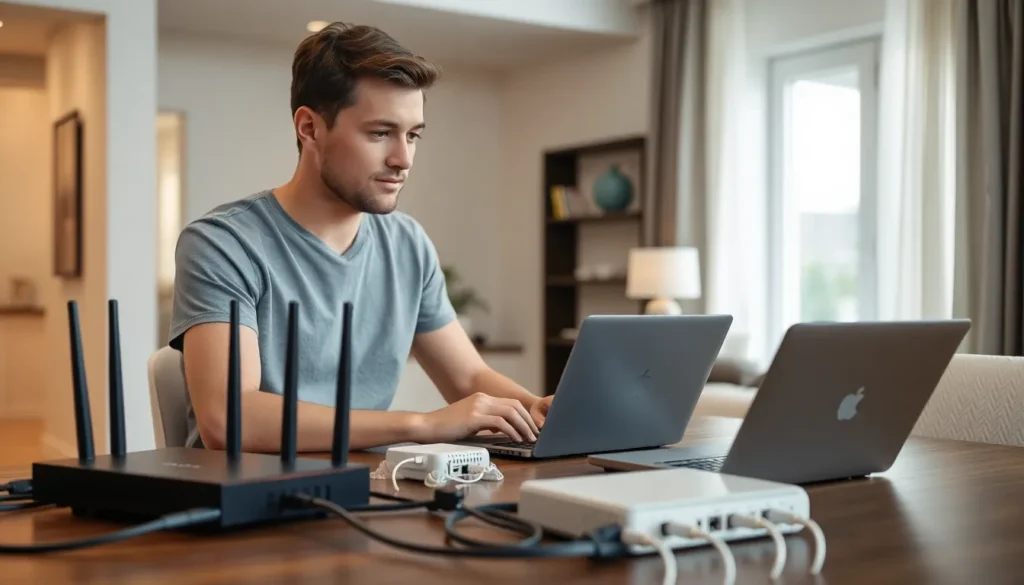In today’s tech-savvy world, a strong home network is as essential as a good cup of coffee—without it, everything just feels sluggish. Whether it’s streaming your favorite shows or working from home, a robust network keeps life running smoothly. But how often does anyone think about the hidden gremlins lurking in their Wi-Fi? That’s where a home network audit swoops in like a superhero with a cape made of Ethernet cables.
Table of Contents
ToggleUnderstanding Home Network Audit
A home network audit assesses the performance and security of a household’s internet connections. This process uncovers potential vulnerabilities and optimizes network efficiency to enhance user experience.
What Is a Home Network Audit?
A home network audit evaluates the components of a network, including routers, devices, and connections. Auditors check for issues like outdated firmware and unsecured passwords. Various tools help streamline the audit process, making it easier to pinpoint problems. This detailed analysis highlights areas for improvement, ensuring a more reliable network.
Importance of Conducting an Audit
Conducting an audit identifies security vulnerabilities that hackers may exploit. Regular evaluations boost network performance, particularly during high-demand activities like streaming. Detection of unauthorized devices can prevent potential disruptions in service. Awareness of network strengths and weaknesses empowers users to make informed decisions regarding upgrades and changes. Ultimately, proactive auditing contributes to a stable and secure online environment.
Steps to Perform a Home Network Audit
To conduct a thorough home network audit, follow these essential steps. A systematic approach ensures all aspects of the network are evaluated effectively.
Assessing Your Current Network Setup
Start by examining the existing network setup. Document the type of router in use alongside its specifications. Check the placement of the router to ensure optimal coverage throughout the home. Evaluate the configuration settings, making adjustments if necessary to enhance performance. Update software and firmware to the latest versions to patch security vulnerabilities. Ensure that the network uses strong encryption standards like WPA3. Regularly reviewing these aspects maintains a secure and efficient network environment.
Identifying Connected Devices
Next, inventory all connected devices on the network. Use the router’s admin interface to view the list of users and devices connected at any given time. Record device names, IP addresses, and MAC addresses for reference. Unrecognized devices may indicate unauthorized access and should be investigated promptly. Ensure each device remains updated and secure. Remove any devices that are no longer in use to limit potential vulnerabilities. Keeping an accurate inventory aids in managing network access and maintaining security.
Tools for Home Network Auditing
Home network auditing relies on a combination of software and hardware tools to enhance performance and security. Each type of tool contributes uniquely to the overall effectiveness of the audit.
Software Solutions
Network scanning software identifies connected devices and assesses their security status. Programs like Nmap or Fing offer detailed reports on device types and vulnerabilities. They simplify the detection of unauthorized connections, pinpointing potential risks to the network. Security-focused tools such as Wireshark monitor traffic flow, analyzing data packets for irregularities. Many software solutions also facilitate password management, ensuring that users employ strong, unique passwords. Regular updates and patch management through software help maintain optimal functioning, keeping systems free from vulnerabilities.
Hardware Tools
Dedicated hardware tools assist in auditing network performance directly. Devices like Wi-Fi analyzers measure signal strength, helping ascertain the best router placement. Signal interference can be detected through these tools, enabling users to optimize coverage. Network extenders improve weak connections by amplifying signals in hard-to-reach areas. Additionally, security cameras and network access controllers offer insights into unauthorized access. Using these devices fosters proactive monitoring and enhances overall network security. Upgrading routers to models with advanced features, such as dual-band support and built-in firewalls, strengthens the network against intrusion.
Common Issues Found in Home Network Audits
Auditing home networks reveals several common issues that may affect overall performance and security. Security vulnerabilities and performance bottlenecks often emerge during these assessments.
Security Vulnerabilities
Weak encryption standards expose home networks to attacks. Many users rely on outdated protocols, making devices susceptible to unauthorized access. Outdated firmware on routers often leads to security holes that hackers can exploit. Unsecured passwords further weaken network defenses, allowing intruders to access sensitive information. Monitoring for any unrecognized devices on the network can also unveil potential threats. By implementing strong encryption methods like WPA3 and regularly updating passwords, individuals strengthen their networks against cyber threats.
Performance Bottlenecks
Network performance bottlenecks frequently stem from inadequate hardware. Many routers in homes struggle to handle multiple devices simultaneously, especially during high-demand activities. Poor router placement creates dead zones, limiting Wi-Fi coverage in certain areas. Bandwidth-hogging devices, such as security cameras or smart home systems, can slow down internet speed for users. Regularly checking the signal strength helps identify interference from neighboring networks. Upgrading to dual-band routers or adding network extenders alleviates these performance issues, ensuring a smoother online experience.
Best Practices for a Secure Home Network
Maintaining a secure home network requires consistent effort and strategic practices. Implementing these best practices enhances both security and performance.
Regular Audits
Performing regular audits serves as a fundamental step in network security. These audits identify potential vulnerabilities that could be exploited by hackers. He or she should document any unrecognized devices connected to the network during the audit. Analyzing network performance metrics reveals issues such as slow speeds or connection dropouts. Regular reviews of devices and network settings fortify security measures. Each audit allows for adjustments that keep the network secure and efficient.
Updating Firmware and Software
Updating firmware and software protects against new threats. Keeping router firmware current often closes security gaps that hackers could exploit. Users should check for automatic updates to ensure peace of mind. Regular updates for connected devices, including smart home gadgets, also improve performance and security. Optimizing settings post-update helps maintain an efficient network. Employing robust password management tools simplifies user experience while promoting safety.
A home network audit is an essential step toward ensuring a secure and efficient online experience. By regularly assessing network performance and security, individuals can proactively address vulnerabilities and optimize their setup. This not only enhances daily activities like streaming and remote work but also protects against potential threats from unauthorized access.
Implementing the best practices outlined in the article will empower users to maintain a robust network environment. With the right tools and consistent effort, anyone can transform their home network into a reliable and secure hub that meets the demands of modern technology. Prioritizing these audits will ultimately lead to a smoother and safer online experience.





